Searching for Consistent Greatness: Wide Receivers

Wide receivers are so ‘in’ right now. In the April ADP data, they make up seven of the top ten, 16 of the top 20 and 29 of the top 50. Of course, there is good reason for this as talent at the position may have never been so deep. When we draft and build our dynasty rosters, we must take that depth into account and answer the question of if we load up on these talented players early. Perhaps we try and win elsewhere, knowing we can still get good talent later? I don’t believe in picking simply for ‘positions’ (the focus should be on the specific players), but going wide receiver heavy is the safest and most beneficial way to build right now. However, there is a lot of potential and ‘projected breakouts’ at the top of drafts. Many of these young players will improve, but there is also the chance that they will fail to live up to the hype (see Cordarrelle Patterson, Justin Hunter or Michael Floyd). The focus of this piece is to review the consistency of players who have been producing over the last three years.
The Method
Once again, I used the same process as I did with quarterbacks and running backs, starting with deciding on the minimum points required to be a ‘WR1’ (top 12) or ‘WR2’ (top 24). I calculated these by going through every week from the start of 2012 to the end of 2014 and working out the average score for these weekly finishes.
The points required were as follows:
- WR1: 20.2
- WR2: 14.7
I then proceeded to go through the top players according to DLF ADP and tally how many times they had placed in the top 24 in the last three seasons, comparing that with how many games they had played in that time to create percentages. With such a large group, I ended up with a list of 55 players who feature in this research (13 of them were 2014 rookies). Cody Latimer, Marquess Wilson, Jeff Janis and Albert Wilson are absent as they have not yet registered a qualifying game. The 2014 rookies are separated from veterans, but after the year they had, I felt it was right to lead off with them.
Here goes!
Notes
- Data was taken from FFToday.com (http://fftoday.com/stats/playerstats.php)
- PPR scoring
- Playoff games were not included
Key
- G – Total games possible to have played in
- GP – Number of games played
- WR1/2 – Number of games with 14.7+ points
- WR1 – Number of games with 20.2+ points
- WR2 – Number of games with between 14.7 and 20.1 points
- % – Percentage of games placing in each category
The numbers to focus on when looking at each list are highlighted (green = good, red = bad).
[am4show have=’g1;’ guest_error=’sub_message’ user_error=’sub_message’ ]
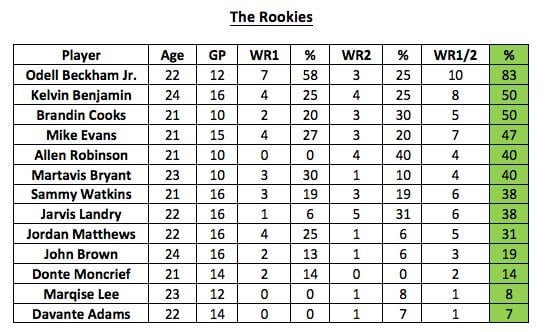
- Odell Beckham blows the competition out of the water (and you’ll see it’s not just this fellow first year group)
- Allen Robinson led the WR2 percentage list, and seems to be dividing opinion. What’s his real upside?
- It is also no surprise Jarvis Landry had the most number of WR2 weeks. He finished a very solid rookie campaign with nine straight double-digit games
- Jordan Matthews gave us four big games with a couple of multi-TD weeks, but was only the ninth-best rookie in top 24 percentage and provided measly single digits in half of his games
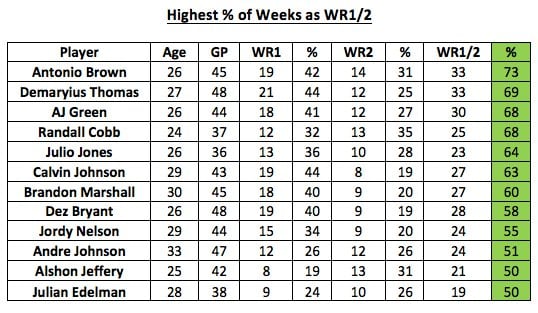
- Antonio Brown’s numbers are mind-numbingly consistent. Last year, he scored 13.4 points or more in every single game and was at least a WR2 every game except that one (94%). Over the last two years, he has scored double digits every single week
- An interesting name at number four is Randall Cobb. He cracked the top ten receivers in April ADP and looks like he could be even higher. He played in seven fewer games than teammate Jordy Nelson over the last three years, but had top 24 scoring one more time
- Andre Johnson dipped last year with his lowest points-per-game average since 2005 and only four top-24 finishes, but offers a good chance at a comeback year paired with Andrew Luck
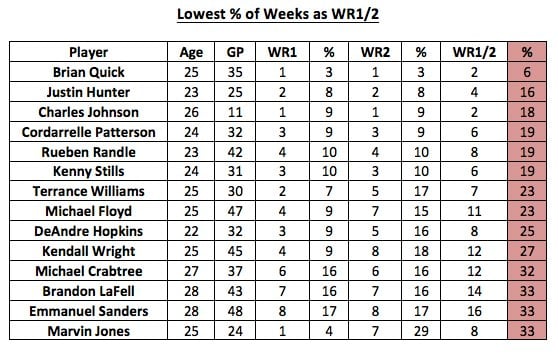
- Patterson and Hunter were last year’s breakout candidates who hadn’t done anything yet. If you want to give them one more chance, they have ADPs of 106 and 126 respectively
- The odd name out here? DeAndre Hopkins. Granted, his low rookie scoring is included, but he only had one ‘impact’ game in 2014 with a huge 44.8 points and only one other top 12 score. Yet, he is being drafted as a top 14 overall dynasty player. I spoke on the DLF Podcast of the ‘Doug Martin Effect’ (a massive ADP rise due to a small number of huge games that were an unfair reflection of a yearly score) and I believe something similar may be happening to Hopkins
- The two players on this list to have recent situational changes (Emmanuel Sanders and Brandon Lafell) dramatically improved their percentages in 2014. With Denver, Sanders was in the top 24 ten times, with seven of those being WR1 games (43% on the year). He also only had two single digit scoring games. Lafell posted career bests in receptions, yards, touchdowns and fantasy points.
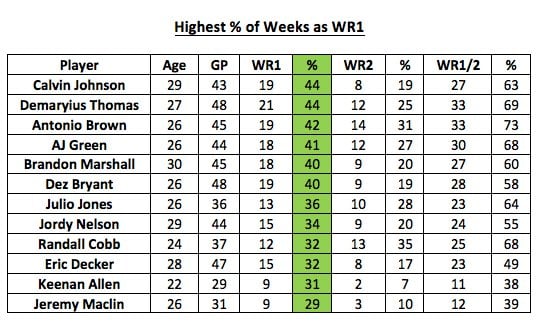
- Calvin Johnson and Demaryius Thomas love to blow it up (often)
- Brandon Marshall shows up again. In 2012 and 2013, he only had four games where he scored fewer than ten points. However in 2014, he only had four WR1 games and missed out on the top 24 in eight of 13 games
- Eric Decker makes the list mostly due to his time at Denver. In New York, he scored 38.1 in the final game of the season, but spent half of his games out of the top 24
- Keenan Allen only had one less WR1 game in 2014 than his rookie year, but he missed the top 24 in every other game (29% ‘WR1/2’ rate on the year)
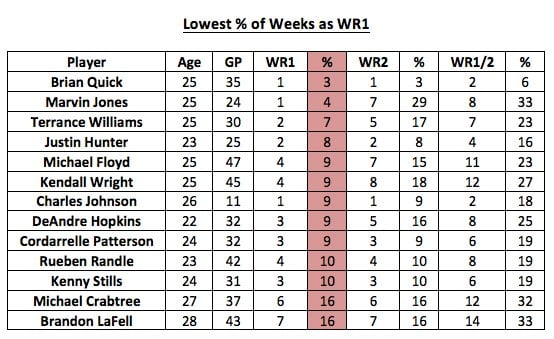
- Michael Floyd once again shows up on a bad list. He has given us one huge scoring week in the second half of every year to keep us hooked (30.6 in 2012, 31.3 in 2013 and 35.3 in 2014), but I will gladly take the under on a good statistical season next year
- Marvin Jones has only had one WR1 game (a four-TD, 44.2 point performance) which made up 23% of his 2013 total of 188.7
- After showing some promise early in his rookie year, Terrance Williams fizzled out to a very unimpressive level in 2014, with only one top 24 finish in his last ten games

- Marvin Jones stands out on this list. Despite the one-off WR1 game mentioned above, he did enjoy a great stretch of top 24 production in 2013. He currently sits at WR70 in the ADP data and could be a decent buy heading into year four
- Roddy White has had remarkably similar numbers to Andre Johnson. He is on the list of vets whose value will only go down, but the immediate production might be worth the price drop
- I was surprised to see TY Hilton on the high WR2 list, not the low WR1 list. He has been progressively more consistent throughout his career, after scoring in bunches early. In 2013 for example, he scored 31.0, 37.1 and 26.5 in three games (94.6) which made up a whopping 43% of his 220.6 on the year (in eight games that year, he didn’t reach double digits). In 2014, by contrast, he scored 12.5 or more in 11 of 15 games.
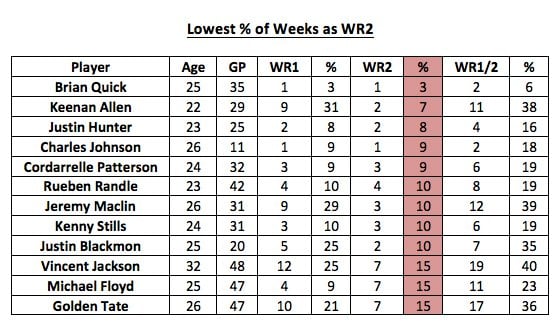
- Keenan Allen is a bit of an anomaly in the data. His WR1 percentage is much higher than his WR2 percentage, meaning that if he has a good fantasy week; it’s usually a great one. His four WR1 weeks in 2014 made up 58% of his yearly total, but he didn’t have a top 24 score in any of his other ten games
- Despite Jeremy Maclin’s great 2014 yearly score, he finished out of the top 24 nine times in 16 games, including five of the last six
- Golden Tate was a loser in last year’s research, but his switch to Detroit and a Calvin Johnson injury certainly boosted him in last year as he had double digit scoring games through the first ten weeks
- We know Patterson has been a disappointment so far, but only one game with over 100 yards receiving and two games with over five catches? What now?

- Part of the reason why Dez Bryant has held the top overall dynasty ADP for most of the last six months is due to the fact that he is always on the field. Sometimes, the best ability is availability.
- Torrey Smith has been hard to figure out for me, and also provides some great examples of how real-life production and fantasy scoring are so different. In 2013, he had a line of 65-1128-4 for 201.8 points (WR23), whereas in 2014, he went 49-767-11 for 191.7 points (WR29). Similar yearly scores, but different ways of getting them.

- Most of these players have experienced a large drop in ADP at some point in the last three years. If Justin Blackmon, Josh Gordon and Victor Cruz produce at the same level that they have in the past, for example, then they are worth acquiring while their prices are low
- Charles Johnson sat out 2013, so the percentage might be slightly unfair, but he still only managed one WR1 game and one WR2 game last year
- Percy Harvin spent 10 of his 13 games in 2014 out of the top 24 and scored 59.4 of his 131.5 points in two games (45%). Have his best days been and gone?
Superstar Weeks
Superstar weeks separate the men from the boys. The average top overall score for a wide receiver each week was 38.1, so I used the difference between that score and the WR1 baseline (20.2) to create a ‘Superstar’ baseline of 29.1 points.
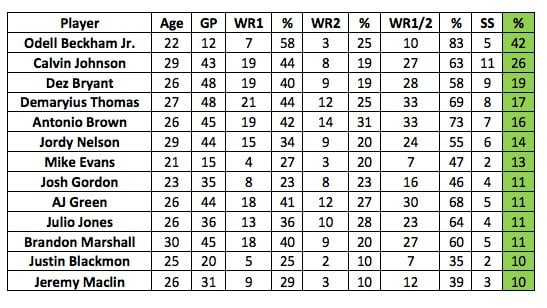
- Odell Beckham is in a league of his own
- 29.1 or more points in 11 games over the past three years will have won Calvin Johnson owners a lot of leagues. I expect a few more years of it at a declining price
- Among players who haven’t had SS weeks: Sammy Watkins, Kelvin Benjamin and Larry Fitzgerald.
- The last three years have been pretty damning for Fitzgerald, especially 2014 where he scored 71 of his 153.4 points in just three games (46%). Do we blame his quarterback play or has he ‘fallen of the cliff?’
Summary
The major noticeable thing about all these results right from the beginning was how low they were compared to the other positions.
Some thoughts:
- Wide receiver top 24 scoring in general is higher than the other positions, as evidenced by the 14.7 point baseline (highest across all positions), so it is simply harder to get in there. Even the average top overall receiver scorer (38.1) was only 0.1 points behind the top scoring QB every week (38.2)
- More receivers see the field and contribute with fantasy production than other positions; meaning that there are more players vying for the top 24. One ‘significant’ dynasty receiver may have a good week, but there will be others who score more. As a yearly comparison, 52 WRs scored over 150 fantasy points, compared to 30 QBs, 23 RBs and only 12 TEs
- With the amount of leagues that require three starting receivers or allow three or more, it is not absolutely essential to be in the top 24. A ‘WR3’ (top 36) would still score enough to contribute to your team’s success. It would be beneficial to include a ‘WR3’ baseline, and I may do that in future research
Of the positions covered so far, this may have been the most eye-opening. Whether it was the low scoring as a group, the excellence of Randall Cobb or the underwhelming DeAndre Hopkins, I learned a whole lot by examining these weekly scores. With every article, I am reminded real production comes from veterans. There is recency to rookie success, but it is also a rarity. While I absolutely encourage dynasty teams to be built around young players whose value will grow and acquiring talent before they break out, there is no doubt that the chances of a winning season increase when you are starting veteran players in their prime. That said, the 2014 class is now a group of ‘vets’; so get your popcorn ready for some great seasons from these sophomores.
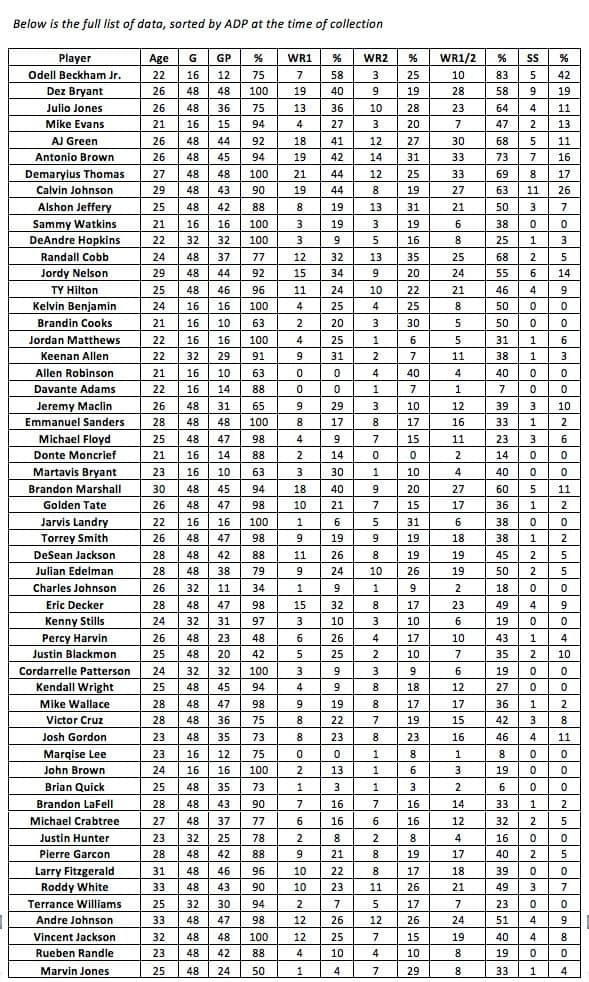
[/am4show]
- 2022 Rookie Class: An Early Look at Kenny Pickett, QB Pittsburgh - January 31, 2022
- Dynasty Fantasy Football Rookie Update: Quez Watkins, WR PHI - July 15, 2020
- Dynasty Fantasy Football Rookie Update: John Hightower, WR PHI - July 7, 2020

































































